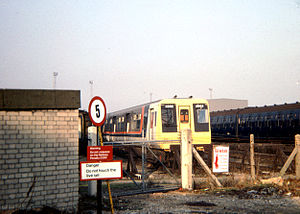British Rail Classes 445 and 446
| British Rail Class 445 and 446 | |
|---|---|

4PEP unit No.4002 in the sidings at Wimbledon depot
|
|
| In service | 1971-1980 |
| Manufacturer | BREL |
| Order no. |
|
| Built at | BREL York |
| Family name | 1972 design (PEP) |
| Constructed | 1971 |
| Entered service | 1973 |
| Number built |
|
| Number scrapped |
|
| Formation | 2/4 cars per trainset:
|
| Diagram |
|
| Design code |
|
| Fleet numbers |
|
| Capacity |
|
| Operator(s) | British Rail |
| Specifications | |
| Train length |
|
| Car length |
|
| Width | 9 ft 3 in (2.82 m) |
| Height | 11 ft 6 1⁄2 in (3.518 m) |
| Doors | Bi-parting sliding |
| Maximum speed | 75 mph (121 km/h) |
| Weight |
|
| Traction motors | 4 × GEC (per car) |
| Power output | 4 x 100 hp (75 kW) (per car)
|
| Electric system(s) | 750 V DC third rail |
| Current collection method | Contact shoe |
| Bogies |
|
| Braking system(s) |
|
| Coupling system |
|
| Multiple working | Within type only |
| Track gauge | 1,435 mm (4 ft 8 1⁄2 in) standard gauge |
The PEP Stock were prototype electric multiple units used on British Rail's Southern and Scottish Regions during the 1970s and early 1980s. They were forerunners of the British Rail Second Generation electric multiple unit fleet. Three units were built, one two-car unit (2001), and two four-car units (4001/4002). Under TOPS, the driving cars were originally classified as Class 461 with the non-driving motor cars as Class 462. They were later reclassified as Class 445 (4PEP) and Class 446 (2PEP).
Internal layout was for commuter services; low-backed, bus-style 2+2 seating in open saloons, wide gangways with hanging straps, and no lavatory facilities. They were the first electric multiple units designed by British Rail with electric sliding doors, outside the Scottish Region. They were unable to operate with any other stock due to their new coupling system. Externally, 2001 was finished in unpainted aluminium, while 4001/4002 were painted in all-over Rail Blue. In passenger use, they normally operated together as a ten-car formation.
All three units were initially assigned to the South Western Division of the Southern Region, based at Wimbledon Park and Strawberry Hill. Upon arrival, they were used under an extensive testing programme prior to entering full passenger service in June 1973, on services from Waterloo to Chessington South, Hampton Court and Shepperton. In August 1973, all three units were moved to the South Eastern Division, where they worked services from Cannon Street/Charing Cross to Bromley North, Dartford and Sevenoaks. Although capable of being used as a single 10-car formation on the SED, a number of failures saw them returned to the SWD after a month. The Class 446 unit was withdrawn from traffic in August 1974, while the two Class 445s were officially withdrawn from revenue service in May 1977.
...
Wikipedia
